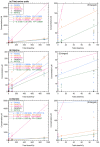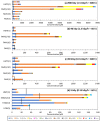Gamma-Ray-Induced Amino Acid Formation during Aqueous Alteration in Small Bodies: The Effects of Compositions of Starting Solutions
- PMID: 38255718
- PMCID: PMC10817335
- DOI: 10.3390/life14010103
Gamma-Ray-Induced Amino Acid Formation during Aqueous Alteration in Small Bodies: The Effects of Compositions of Starting Solutions
Abstract
Organic compounds, such as amino acids, are essential for the origin of life, and they may have been delivered to the prebiotic Earth from extra-terrestrial sources, such as carbonaceous chondrites. In the parent bodies of carbonaceous chondrites, the radioactive decays of short-lived radionuclides, such as 26Al, cause the melting of ice, and aqueous alteration occurs in the early stages of solar system formation. Many experimental studies have shown that complex organic matter, including amino acids and high-molecular-weight organic compounds, is produced by such hydrothermal processes. On the other hand, radiation, particularly gamma rays from radionuclides, can contribute to the formation of amino acids from simple molecules such as formaldehyde and ammonia. In this study, we investigated the details of gamma-ray-induced amino acid formation, focusing on the effects of different starting materials on aqueous solutions of formaldehyde, ammonia, methanol, and glycolaldehyde with various compositions, as well as hexamethylenetetramine. Alanine and glycine were the most abundantly formed amino acids after acid hydrolysis of gamma-ray-irradiated products. Amino acid formation increased with increasing gamma-ray irradiation doses. Lower amounts of ammonia relative to formaldehyde produced more amino acids. Glycolaldehyde significantly increased amino acid yields. Our results indicated that glycolaldehyde formation from formaldehyde enhanced by gamma rays is key for the subsequent production of amino acids.
Keywords: amino acids; aqueous alteration; carbonaceous chondrites; prebiotic chemistry.
Conflict of interest statement
The authors declare no conflicts of interest.
Figures









References
Grants and funding
LinkOut - more resources
Full Text Sources

